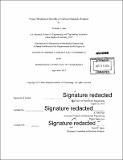| dc.contributor.advisor | A. John Hart. | en_US |
| dc.contributor.author | Dee, Nicholas T. (Nicholas Thomas) | en_US |
| dc.contributor.other | Massachusetts Institute of Technology. Department of Mechanical Engineering. | en_US |
| dc.date.accessioned | 2016-02-29T15:00:19Z | |
| dc.date.available | 2016-02-29T15:00:19Z | |
| dc.date.copyright | 2015 | en_US |
| dc.date.issued | 2015 | en_US |
| dc.identifier.uri | http://hdl.handle.net/1721.1/101328 | |
| dc.description | Thesis: S.M., Massachusetts Institute of Technology, Department of Mechanical Engineering, 2015. | en_US |
| dc.description | Cataloged from PDF version of thesis. | en_US |
| dc.description | Includes bibliographical references (pages 113-119). | en_US |
| dc.description.abstract | Carbon nanotubes (CNTs) can have exceptional mechanical, thermal, and electrical behavior, but successful use of CNTs in macroscale materials requires scalable processes to organize CNTs while preserving their intrinsic properties. Although the chemical influences on CNT growth have been subject to significant research, the effect of mechanical forces, which have been shown to influence the kinetics of many chemical reactions, remains unclear. When CNTs grow into vertically aligned "forest" structures by chemical vapor deposition (CVD), entanglement and attractive forces among the CNTs cause the CNTs to become mechanically coupled. Further, because there is a distribution of sizes, orientations, and growth rates amongst individual CNTs within a forest, it has been suggested that coupled CNTs develop forces that are transmitted to the growth interface at the catalyst. The goal of this thesis is to investigate the effects of applied mechanical forces and intrinsic forces that result from mechanical coupling on CNT growth. Using a custom-built chemical vapor deposition system including a micromanipulator that can apply compressive loads to a CNT forest and measure its height in real-time, the effects of extrinsic mechanical forces on the growth kinetics and forest morphology were studied. It was found that forces as small as 0.1 nN per CNT decrease the collective growth rate of the CNT forest along with its terminal height. Furthermore, time-varying forces can be used to induce a morphological change in the forest structure and modulate the apparent growth rate without causing termination. Next, a finite element model was developed to simulate the forces exerted between a pair of CNTs growing at different rates and coupled by van der Waals forces. The simulation predicts that mechanical coupling between CNTs enables forces exceeding 10 nN to be transmitted to the catalyst, which are potentially several orders of magnitude larger than the externally applied forces that were found experimentally to influence forest growth. Together, these findings suggest that the quality and growth rate of CNT forests may be limited by CNT-CNT mechanical coupling and force transmission to the catalyst, and motivate future work using controlled forces to manipulate the quality and morphology of CNTs for various applications. | en_US |
| dc.description.statementofresponsibility | by Nicholas T. Dee. | en_US |
| dc.format.extent | 119 pages | en_US |
| dc.language.iso | eng | en_US |
| dc.publisher | Massachusetts Institute of Technology | en_US |
| dc.rights | M.I.T. theses are protected by copyright. They may be viewed from this source for any purpose, but reproduction or distribution in any format is prohibited without written permission. See provided URL for inquiries about permission. | en_US |
| dc.rights.uri | http://dspace.mit.edu/handle/1721.1/7582 | en_US |
| dc.subject | Mechanical Engineering. | en_US |
| dc.title | Force-modulated growth of carbon nanotube forests | en_US |
| dc.title.alternative | Force-modulated growth of CNT forests | en_US |
| dc.type | Thesis | en_US |
| dc.description.degree | S.M. | en_US |
| dc.contributor.department | Massachusetts Institute of Technology. Department of Mechanical Engineering | |
| dc.identifier.oclc | 938852410 | en_US |
